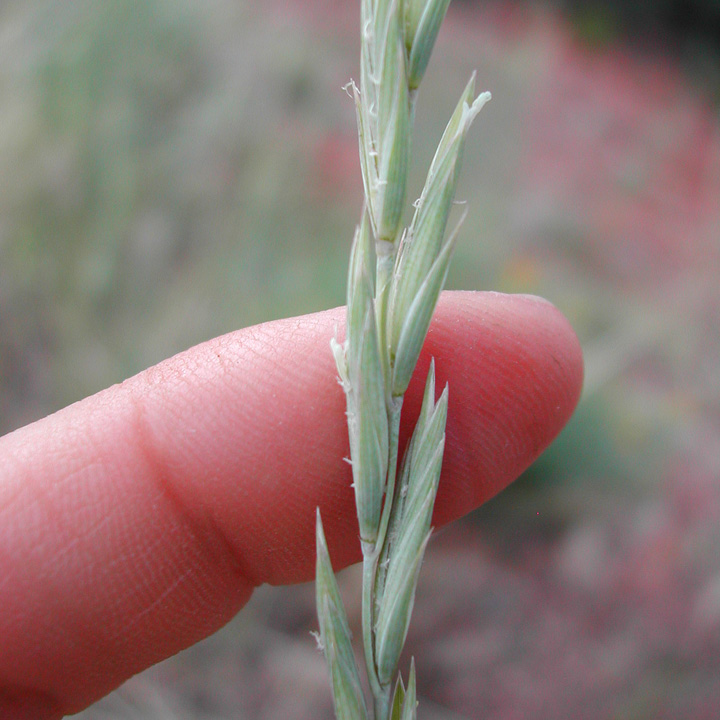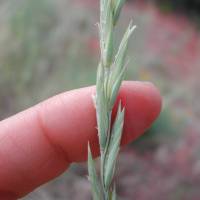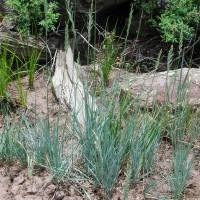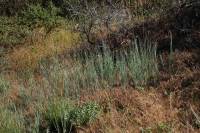Culms 20-100 cm, glabrous. Auricles 0.2-1 mm, often purple; ligules about 0.1 mm; blades 2-26 cm long, 1-4.5 mm wide, decreasing in length upwards, spreading, rigid, adaxial surfaces with prominent veins. Spikes 5-17 cm; middle inter-nodes 4.5-11 mm. Spikelets 12-26(30) mm, with 2-12 florets; lowest rachilla internodes in each spikelet 0.8-2 mm long, 0.5-0.9 mm wide at the top. Glumes 5-15 mm, lower glumes usually exceeded by the upper glumes; lower glumes 0.15-0.8 mm wide at 3/4 length; lemmas 6-14 mm, unawned or awned, awns 0.5-5 mm. 2n = 56.
Pascopyrum smithii is native to sagebrush deserts and mesic alkaline meadows, growing in both clay and sandy soils. Pascopyrum smithii is probably derived from a Leymus triticoides-Elymus lanceolatus cross (Dewey 1975); it is frequently confused with both. Leymus triticoides differs in usually having 2 spikelets per node and glumes that are narrower at the base. In E. lanceolatus, the leaves tend to be more evenly distributed and the glumes have straight midveins, become narrow beyond midlength, and tend to be wider at 3/4 length (0.35-1.6 mm). In addition, the first rachilla internodes of E. lanceolatus are often longer and narrower (the length/width ratio averaging 2.6, versus 1.8 in P. smithii). No infraspecific taxa of P. smithii are recognized here.
All of my specimens were found along railroads, where the colonies will doubtless persist and spread. Apparently it does not propagate as vigorously as the preceding species [Elymus repens], but, when discovered, it should be eradicated. This is a western species that has been introduced eastward of Iowa and Kansas.
Common Name: western wheatgrass
Duration: Perennial
Nativity: Native
Lifeform: Graminoid
General: Strongly rhizomatous perennial grass with firm stems 20-100 cm tall.
Vegetative: Blades basally concentrated, 2-26 cm long, 1-4.5 mm wide, firm to stiff, glaucous (with a bluish tinge), tapering to a slender point, upper surface with prominent veins; ligules membranous, about 0.1 mm; sheaths striate when dry, smooth, rarely pilose, wi
Inflorescence: Terminal distichous spikes 5-17 cm long with middle internodes 4.5-11 mm; usually one spikelet per node, occasionally in pairs at lower nodes; spikelets at lower 4-6 nodes often sterile; spikelets 12-26 mm, 1-3 times the length of internodes, straight, usually ascending not appressed, with 2-12 florets; disarticulation above the glumes, beneath the florets; glumes unequal, 5-15 mm, half to two thirds the length of the spikelets, usually narrowly lanceolate, stiff, not keeled, 3-5 veined basally, apices acuminate; lemmas lanceolate, rounded on the back, mucronate to awned, the awns to 5 mm, straight.
Ecology: Found on dry flats, slopes, in both clayey and sandy soils from 3,000-8,000 ft (914-2438 m); flowers June-August.
Distribution: Throughout western and central North America, from the Great Lakes region to British Columbia, south to TX, NM, AZ and CA
Notes: This rhizomatous, awnless to short awned perennial in the Elymus-Leymus compex is distinctive with the glaucous and bluish tinge to its foliage, as well as the purple auricle and the distichous spikes. Often forms large pure types in sandy areas and bottom lands of alkaline meadows. According to FNA, the species is allooctoploid and probably derived from a Leymus triticoides-Elymus lanceolatus cross (both of those genomes are tetraploid); it is frequently confused with both its parent species. Leymus triticoides differs in usually having 2 spikelets per node and glumes that are narrower at the base. In E. lanceolatus, the leaves tend to be more evenly distributed and the glumes have straight midveins, become narrow beyond midlength, and tend to be wider at 3/4 length (0.35-1.6 mm). While Flora of North America uses the name Pascopyrum smithii, the Flora Neomexicana (2012) uses the name Elymus smithii for this taxon.
Ethnobotany: Eaten as forage, and used to soak melon seeds to keep worms away and to make melons sweeter.
Etymology: Pascopyrum is from Latin pasco, to feed or pasture and Greek pyros, for grain or wheat, while smithii is named for Jared Gage Smith (1866-1925) a USDA botanist.
Synonyms: Agropyron smithii, Agropyron molle, Agropyron smithii var. molle, Agropyron smithii var. palmeri, Elymus smithii, Elytrigia smithii, Elymus smithii var. mollis
Editor: SBuckley 2010, AHazelton 2015
Strongly rhizomatous, usually glaucous, 3-8 dm; lvs flat, becoming involute in drying, 2-4.5 mm wide, the upper surface scabrous and sometimes pilose, strongly ridged and furrowed, with ca 7-14 furrows across the width; spikes stiff, erect, 5-15 cm, the middle internodes 5-10+ mm; spikelets 12-24 mm, mostly 4-8-fld, sometimes some of them in pairs; glumes slender and rigid, gradually tapering from below the middle and passing imperceptibly into a short awn-tip; lemmas 8-11+ mm, glabrous to sometimes densely short-hairy, awn-pointed or with an awn to 5 mm; glumes and lemmas only faintly veined; anthers 2-4.5 mm; 2n=56. Dry, open places, often in alkaline bottomlands; widespread in w. U.S., e. to Minn., Io., and Mo., and casually to N.Y. and Ky. (Agropyron s.; Pascopyrum s.) Thought to be an alloploid of E. dasystachya and Leymus triticoides.
Gleason, Henry A. & Cronquist, Arthur J. 1991. Manual of vascular plants of northeastern United States and adjacent Canada. lxxv + 910 pp.
©The New York Botanical Garden. All rights reserved. Used by permission.







